Chinese Garden and the Eight Singapore Immortals
In my last post I mentioned that the Japanese and Chinese Gardens exist as a result of city planning decisions – that in the industrial wastes that would eventually occupy the Jurong swamps, Singapore’s government realized that people needed a place to go for greenery, tranquility, and recreation. Naturally, since this is Singapore, we could not have these things without a wee smidgin of cultural and moral inculcation. So outside the Song-Dynasty-style seven-story pagoda, facing the MRT station and the main access point to the garden, is a series of eight statues of great historical figures from China’s past. The most recent figures are closest to the MRT bridge; as you go down the line of figures, you recede in time from the present. Among the eight statues are two women, a eunuch and a possibly gay man, so inclusiveness is the order of the day. Although this particular type of inclusiveness may have been an accident.
I should mention here that it’s not unusual to find statues of heroes in Asian countries. Lots of Indian villages have Gandhi. Taipei has Sun Yatsen and Chiang Kaishek. Chiayi (in Taiwan) has busts of many (western!) heroes in its city park, including Helen Keller. And let’s not even think about Maoist iconography in mainland China. But Singapore has chosen people long dead, not modern leaders (modest Singapore!); and true to its needs, it has chosen them from Chinese history, to enhance Singaporean Chinese people’s sense of identity and ethnic pride – not to mention that these are the Chinese gardens.
They are pretty good statues, if you like portraits, period costumes, and realism – which I do! Let’s see if we can figure out why these particular ones were chosen – after all, Chinese history supplies 5000 years’ worth of interesting stories and characters.
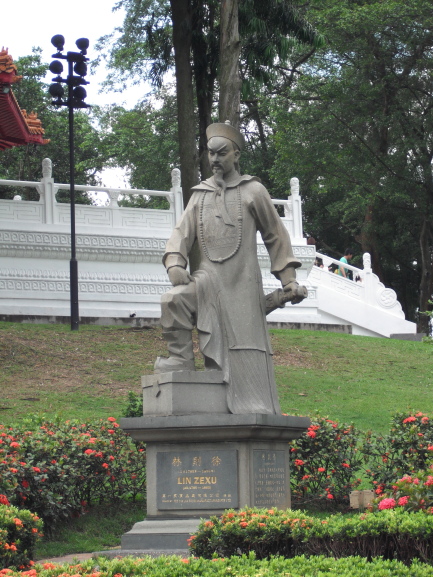 The first one you encounter is Lin Zexu, an official under the Qing Dynasty. This man tried to fight the British opium importers and protect Chinese people, by burning down a warehouse full of opium in 1840. This started the Opium War, which in turn led to the humiliation of China and its domination by foreign powers. So why is he a hero? Because he took a strong stand against drugs, when it would have been much easier and more profitable not to. Drug interdiction – a very Singaporean virtue!
The first one you encounter is Lin Zexu, an official under the Qing Dynasty. This man tried to fight the British opium importers and protect Chinese people, by burning down a warehouse full of opium in 1840. This started the Opium War, which in turn led to the humiliation of China and its domination by foreign powers. So why is he a hero? Because he took a strong stand against drugs, when it would have been much easier and more profitable not to. Drug interdiction – a very Singaporean virtue!
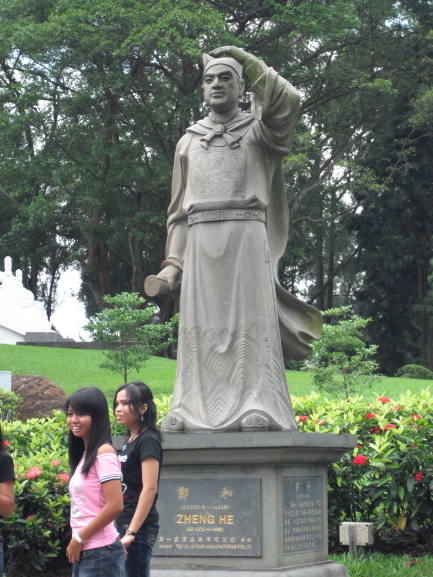 Next is Zheng He, whose distinctive hat shows his status as a eunuch. But more importantly, he was a great navigator and explorer who lived from 1371-1435, and led the Chinese navy to southeast Asia (i.e., Singapore!) and East Africa. He was also, not coincidentally, a Chinese Muslim. So he is an exemplar of a multicultural China, who showcases the virtues of duty, patriotism, bravery, brains, and sea-going savvy. This last is important to Singapore, much of whose industry is related to modern cargo-carriers.
Next is Zheng He, whose distinctive hat shows his status as a eunuch. But more importantly, he was a great navigator and explorer who lived from 1371-1435, and led the Chinese navy to southeast Asia (i.e., Singapore!) and East Africa. He was also, not coincidentally, a Chinese Muslim. So he is an exemplar of a multicultural China, who showcases the virtues of duty, patriotism, bravery, brains, and sea-going savvy. This last is important to Singapore, much of whose industry is related to modern cargo-carriers.
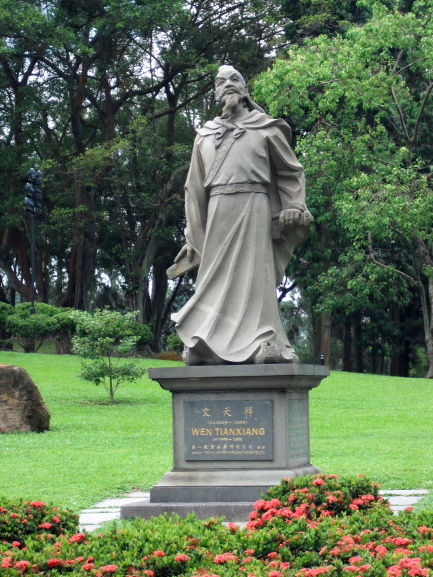 This is Wen Tianxiang, 1236-83. He was a scholar, official and general loyal to the fading Song Dynasty, who refused to assist the invading Mongols (Kublai Khan), despite being imprisoned and tortured. All in vain, actually, since the Song were at that time too weak to fend off the invaders and fell anyway, leading to the establishment of the Yuan dynasty. Like the Manchus years later, the Mongols were perceived as outsiders unworthy of refined Han culture – mostly by Hans, of course. Why should Singapore, a multicultural city, celebrate a guy who tried to defend a monocultural, corrupt and inept regime? Patriotism, I think, and incorruptibility.
This is Wen Tianxiang, 1236-83. He was a scholar, official and general loyal to the fading Song Dynasty, who refused to assist the invading Mongols (Kublai Khan), despite being imprisoned and tortured. All in vain, actually, since the Song were at that time too weak to fend off the invaders and fell anyway, leading to the establishment of the Yuan dynasty. Like the Manchus years later, the Mongols were perceived as outsiders unworthy of refined Han culture – mostly by Hans, of course. Why should Singapore, a multicultural city, celebrate a guy who tried to defend a monocultural, corrupt and inept regime? Patriotism, I think, and incorruptibility.
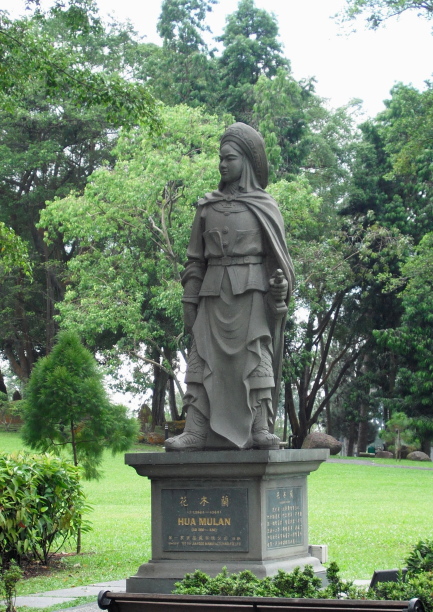 Hwa Mulan, the only woman celebrated for her own military accomplishments. Also the one with the least historical documentation; if she lived, it might have been during the Northern Wei period, 386-584. The main points about her are that she disguised herself as a man and served in the army under her father’s name for some period – 10 years? 30? Her strategic gifts allowed her to rise to the post of general (I find it hard to believe nobody figured out her gender), and the emperor, in gratitude, granted her the fulfillment of a wish, any wish. Apparently she just wanted to return home. So she did, says the story, and resumed her work at the loom. She is now worshipped in the Taoist tradition, not for her bravery, smarts, or patriotism, but as an exemplar of filial piety – surprise! Feminism de-fanged by religion.
Hwa Mulan, the only woman celebrated for her own military accomplishments. Also the one with the least historical documentation; if she lived, it might have been during the Northern Wei period, 386-584. The main points about her are that she disguised herself as a man and served in the army under her father’s name for some period – 10 years? 30? Her strategic gifts allowed her to rise to the post of general (I find it hard to believe nobody figured out her gender), and the emperor, in gratitude, granted her the fulfillment of a wish, any wish. Apparently she just wanted to return home. So she did, says the story, and resumed her work at the loom. She is now worshipped in the Taoist tradition, not for her bravery, smarts, or patriotism, but as an exemplar of filial piety – surprise! Feminism de-fanged by religion.
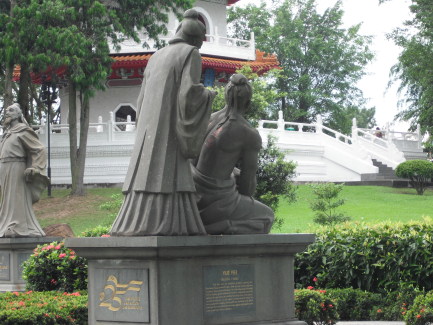 Mulan is not the only woman in the Chinese Garden sculptures; here we have Yue Fei’s mother, tatooing characters into her son’s back. The characters read “Serve the country with utmost loyalty,” and apparently Yue Fei (1103-42) did, as a gifted general defending the Southern Song from Jurchen invaders. It’s not known how having this message in his back was supposed to help instruct him, since he could not see it without mirrors, but that’s the story. Patriotism again, and in this case, rarely for statues in Singapore, a touch of Chinese beefcake.
Mulan is not the only woman in the Chinese Garden sculptures; here we have Yue Fei’s mother, tatooing characters into her son’s back. The characters read “Serve the country with utmost loyalty,” and apparently Yue Fei (1103-42) did, as a gifted general defending the Southern Song from Jurchen invaders. It’s not known how having this message in his back was supposed to help instruct him, since he could not see it without mirrors, but that’s the story. Patriotism again, and in this case, rarely for statues in Singapore, a touch of Chinese beefcake.
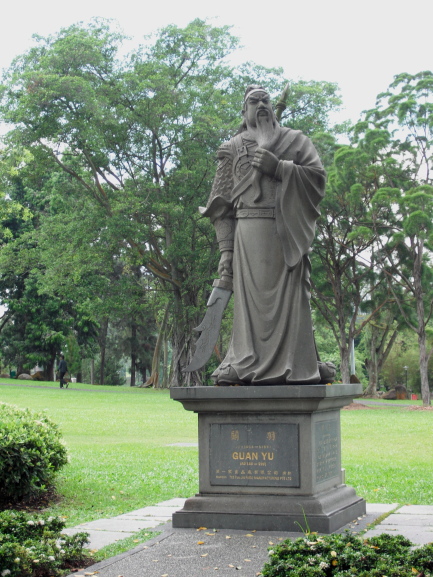 Here’s one of my personal favorites, Guan Yu (died 219). He served the warlord Liu Bai in the wars of the Three Kingdoms Period – during the long and horrible decay of the Han dynasty – and was notable for his fearlessness, resolution, incorruptibility, loyalty, and military effectiveness without boasting or rashness. He’s worshipped everywhere among Chinese people, and you can read about his exploits in the Romance of the Three Kingdoms.
Here’s one of my personal favorites, Guan Yu (died 219). He served the warlord Liu Bai in the wars of the Three Kingdoms Period – during the long and horrible decay of the Han dynasty – and was notable for his fearlessness, resolution, incorruptibility, loyalty, and military effectiveness without boasting or rashness. He’s worshipped everywhere among Chinese people, and you can read about his exploits in the Romance of the Three Kingdoms.
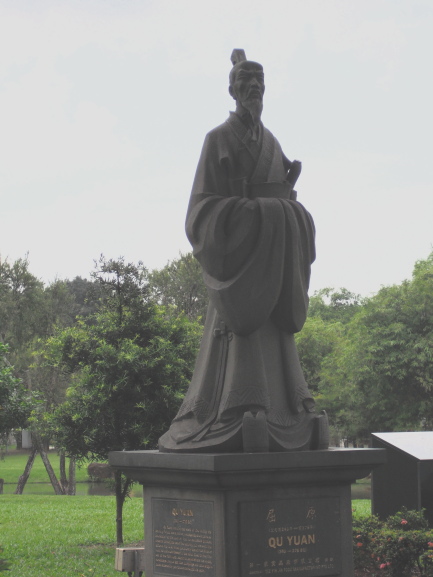 Qu Yuan (340-278 BCE) is the father of Chinese poetry. This is more important than you might think, since poetic ability for many years determined who ran the country (under the system of examinations). He was possibly homosexual. He was also, according to legend, a counselor who lost favor with his local king, spent years writing patriotic poetry in exile, and drowned himself in a river in protest when he learned that his small local kingdom had fallen under the sway of the Qin. (This Qin conquest of the 7 kingdoms was the first ever uniting of the area that would eventually be known as China.) Qu Yuan’s death marked the beginning of the Dragon Boat festival, when the races between boats replays the vain attempts of Qu’s neighbors to row out and rescue him or recover his body. So literacy, patriotism, and a care for local matters.
Qu Yuan (340-278 BCE) is the father of Chinese poetry. This is more important than you might think, since poetic ability for many years determined who ran the country (under the system of examinations). He was possibly homosexual. He was also, according to legend, a counselor who lost favor with his local king, spent years writing patriotic poetry in exile, and drowned himself in a river in protest when he learned that his small local kingdom had fallen under the sway of the Qin. (This Qin conquest of the 7 kingdoms was the first ever uniting of the area that would eventually be known as China.) Qu Yuan’s death marked the beginning of the Dragon Boat festival, when the races between boats replays the vain attempts of Qu’s neighbors to row out and rescue him or recover his body. So literacy, patriotism, and a care for local matters.
And finally:
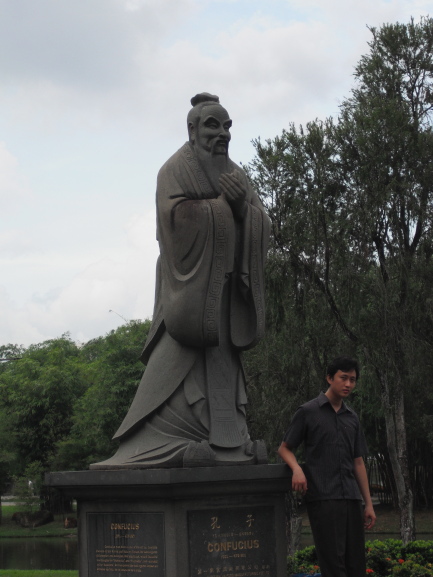 This is the second Confucius statue in the park, so you know he’s super important. He lived from 551-459 BCE, and tried to deal with the disorder and turmoil he saw around him by creating a system for orderly living and reciprocal obligations. Thus the king owes protection to the subjects, who in turn owe obedience to the king. Fathers must behave with justice and dignity in their families, and wives and children must order their lives accordingly. Here in other words is official sanction for the whole system of filial piety. A nice system, until you get one jerk who misbehaves, and then the whole thing collapses. But it was a good try, until it hardened into a ritualistic system of empty gestures and stifling, super-codified proprieties.
This is the second Confucius statue in the park, so you know he’s super important. He lived from 551-459 BCE, and tried to deal with the disorder and turmoil he saw around him by creating a system for orderly living and reciprocal obligations. Thus the king owes protection to the subjects, who in turn owe obedience to the king. Fathers must behave with justice and dignity in their families, and wives and children must order their lives accordingly. Here in other words is official sanction for the whole system of filial piety. A nice system, until you get one jerk who misbehaves, and then the whole thing collapses. But it was a good try, until it hardened into a ritualistic system of empty gestures and stifling, super-codified proprieties.
But the other thing Confucius did was to be a great equalizer (at least in theory), through teaching. He was willing to teach anyone, he said (assuming that anyone was male), not only the sons of the rich, and each person has special gifts and abilities that can be developed and allowed to shine. Confucius is the patron of education, and of teachers. His birthday, September 28, is Teachers’ Day in Taiwan, where it is celebrated oddly enough with a school holiday, in which children get as far from their teachers as is humanly possible.
So the most ancient figure among Singapore’s Chinese heroes celebrates our care and duty to our parents and children; recognition of the potential greatness in every individual; respect for the importance of culture, literacy and thought in our lives. Of course, once you reach this far into antiquity you can read almost anything you like into their lives, and there will be little evidence to contradict you. But let’s assume these ideals of Confucian thought are the values the Singapore government holds dear.